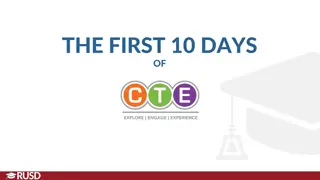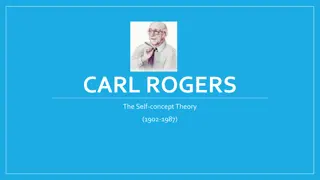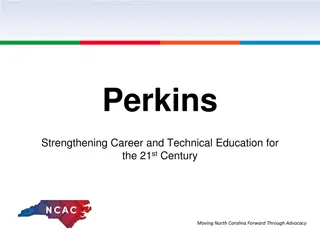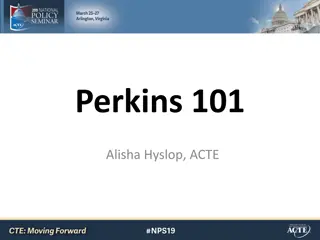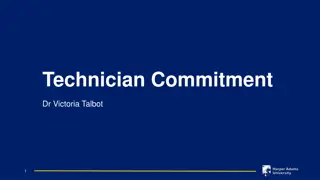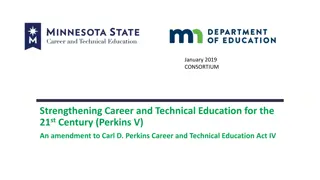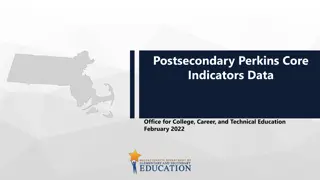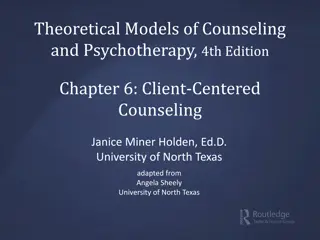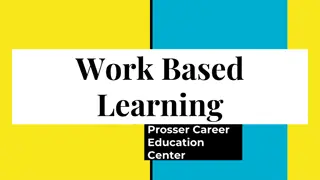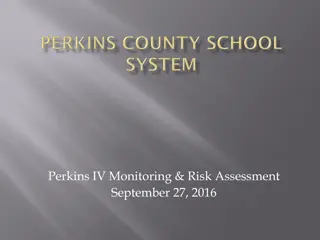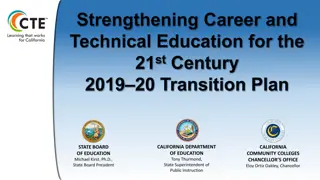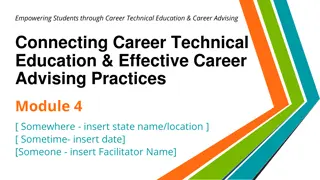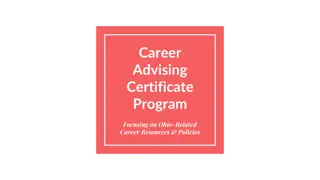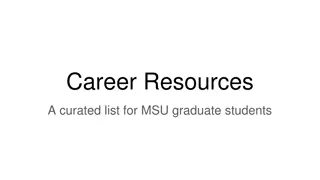Carl D. Perkins Career and Technical Education Act (Perkins V)
Purpose and benefits of the Perkins Act in developing academic, technical, and employability skills in students, promoting partnerships, providing research and technical assistance, and increasing employment opportunities for underrepresented populations.
- Perkins Act
- career and technical education
- academic knowledge
- employability skills
- partnerships
- research
- technical assistance
- employment opportunities
Download Presentation

Please find below an Image/Link to download the presentation.
The content on the website is provided AS IS for your information and personal use only. It may not be sold, licensed, or shared on other websites without obtaining consent from the author. Download presentation by click this link. If you encounter any issues during the download, it is possible that the publisher has removed the file from their server.
E N D
Presentation Transcript
Carl D. Perkins Career and Technical Education Act (Perkins V)
Agenda History Context Administration State comparisons Discussion and Questions
Perkins Act What is its purpose? Develop more fully the academic knowledge and technical and employability skills of secondary education students and postsecondary education students who elect to enroll in career and technical education programs and programs of study. Building on the efforts of States and localities to develop challenging academic and technical standards and to assist students in meeting such standards, including preparation for high skill, high wage, or in-demand occupations in current or emerging professions.
Perkins Act What is its purpose? Promoting the development of services and activities that integrate rigorous and challenging academic and career and technical instruction, and that link secondary education and postsecondary education for participating career and technical education students. Increasing State and local flexibility in providing services and activities designed to develop, implement, and improve career and technical education. Supporting partnerships among secondary schools, postsecondary institutions, baccalaureate degree granting institutions, area career and technical education schools, local workforce investment boards, business and industry, and intermediaries.
Perkins Act What is its purpose? Conducting and disseminating national research and disseminating information on best practices that improve career and technical education programs and programs of study, services, and activities Providing technical assistance that (A) promotes leadership, initial preparation, and professional development at the State and local levels; and (B) improves the quality of career and technical education teachers, faculty, administrators, and counselors. Providing individuals with opportunities throughout their lifetimes to develop, in conjunction with other education and training programs, the knowledge and skills needed to keep the United States competitive.
Perkins Act What is its purpose? Increasing the employment opportunities for populations who are chronically unemployed or underemployed, including individuals with disabilities, individuals from economically disadvantaged families, out-of- workforce individuals, youth who are in, or have aged out of, the foster care system, and homeless individuals.
History The Smith-Hughes Act of 1917 was the first authorization for the Federal funding of vocational education. Promoted vocational education in agriculture, trades and industry, and homemaking and provide federal funds for the first time Basis both for the promotion of vocational education, and for its isolation from the rest of classroom curriculum Spelled out the Federal Government's intent that vocational teachers should be "...persons who have had adequate vocational experience or contact in the line of work..." (Section 12) in which they were to hold classes. Federal funds, as well as State and local funds for vocational education could be spent on salaries of teachers with vocational experience, but not on salaries of academic teachers.
History Subsequent legislation for vocational education (now termed career and technical education) included the: Vocational Act of 1973; morphed into Carl D. Perkins Act of 1984 (Perkins I). Perkins was reauthorized as the Carl D. Perkins Vocational and Applied Technology Act (Perkins II) in 1990 The Carl D. Perkins Career and Technical Education Act of 1998 (Perkins III) The Carl D. Perkins Career and Technical Education Act of 2006 (Perkins IV) The Strengthening Career and Technical Education for the 21st Century Act; re-authorizes the Carl D. Perkins Career and Technical Education Act of 2006 (Perkins V)
History Vocational no longer used Vocational - Preparing students for jobs right out of high school Career and Technical Education Preparing students to be successful in their chosen career College and Career Ready
Perkins V What is required in Perkins State Plans for indicators of performance are for AYs 20-21, 21-22, 22-23, 23-24 Can renegotiate in year 3, but cannot renegotiate if a target was not met Expanded focus on subgroups and special populations Definitions expanded Includes career exploration at the high school level or the middle grades Perkins funds can now be expended down to the 5th grade Comprehensive Local Needs Assessment (CLNA)
Perkins V Consortiums Consortium members must work together to determine how funds are distributed Consortium Members should first look at the data for their consortium and individual schools to determine if they have met all targets. If a target has not been met, money should be used to address that target consortium wide. Consortium members could consider doing consortium wide Professional Development Consortium members could consider buying equipment items in bulk to reduce costs Consortium members could look at sharing equipment for a specific program Consortium members could ensure that all instructors in a particular program across all districts receive the same professional development or equitable equipment.
National and State Profiles Online Tool: https://cte.ed.gov/profiles/national-summary
State Comparisons Analysis of State CTE Standards Full list of Federal Career Clusters State Policies Impacting CTE - 2022 Year in Review Perkins State Plans and Data Explorer
IOWA FY 2024 Division of Community Colleges and Workforce Preparation, Iowa Department of Education 15 Community Colleges 76 Districts/Consortia (327 Public districts) Independent Districts = 34 districts above $15K threshold Consortia = 42 Consortium
IOWA FY 2024 Iowa Perkins V Funding Distribution Iowa Federal Perkins Funding - $14,435,589.00 State Administration - $598,197 (4.1%); state match has not kept pace State Leadership - $1,443,558.90 (10%) 85% available for secondary/postsecondary $12,393,833.10 Of this 85% Reserve (3%) $371,814.99 Secondary - $299,314.99 Postsecondary - $72,500.00 Allocation to Eligible Recipients - $12,022,018.11 Secondary Allocation $5,711,694/06 + $462,464/16 CFWD Postsecondary Allocation $6,310,324.05 + $1,699.00 CFWD
IOWA Perkins V Perkins V State Plan Perkins Local Application Accounting for Perkins Funds Pell Audit Guidance Perkins V Claim Resources Perkins-Funded Equipment Guidelines Perkins Bill Post-Secondary Information Perkins V Secondary and Post Secondary Monitoring Resources
IOWA Perkins V Claim Resources Perkins-Funded Equipment Guidelines
IOWA Perkins Local Application The FY24 Perkins V Secondary and Postsecondary applications are posted in funding opportunities in the IowaGrants.gov system. The application deadline is June 30, 2023. The following guidance, memos, and videos provide more information and assistance for completing the application. Guidance FY24 Perkins Grant Application: General Guidance for Submission Perkins Purchasing FY 2024 Template Career and Technical Student Organizations (CTSO) Student Competition Funding Perkins Consortium FAQs Memos Consortium Requirements for Distribution of Perkins Funds to Secondary Education Webinar Recording FY24 Perkins V Application Webinar
IOWA Kotamraju P., 2012, June. Using return on investment (ROI) and other related tools: Guidelines for measuring career and technical education (CTE) internal efficiency and external effectiveness. Louisville, KY: National Research Center for Career and Technical Education, University of Louisville.
IOWA Iowa Perkins Primary Contacts Dr. Dennis Harden Bureau Chief dennis.harden@iowa.gov Dr. Jeffrey Fletcher IowaGrants, Perkins Accountability, Monitoring, & Reporting jeffrey.fletcher@iowa.gov Amy Vybiral Perkins Claims, Labor Market, & Student Services amy.vybiral@iowa.gov
References Aliaga, O.A., Kotamraju, P., & Stone III, J.R. (2014). Understanding participation in secondary career and technical education in the 21stcentury: Implications for policy and practice. High School Journal. U.S. Department of Education. (2021). Data Story. https://www2.ed.gov/datastory/cte/index.html Friedel, J.N. (2011). Where has vocational education gone? The impact of federal legislation on the expectations, design, and function of vocational education as reflected in the reauthorization of the Carl D. Perkins Career and Technical Education Act of 2006. American Educational History Journal. Laanan, F.S., Compton, J.I., & Friedel, J.N. (2006). The role of career and technical education in Iowa community colleges. Community College Journal of Research and Practice. Kotamraju, P. & Blackman, O. (2011). Meeting the 2020 American Graduation Initiative (AGI) goal of increasing postsecondary graduation rates and completions: A macro perspective of community college educational attainment. Community College Journal of Research and Practice. Perkins Collaborative Resource Network.(2023). U.S. Department of Education, Office of Career, Technical, and Adult Education, Division of Academic and Technical Education, https://cte.ed.gov/.





